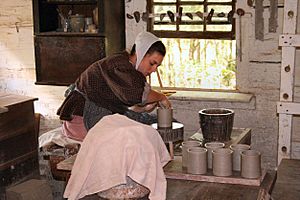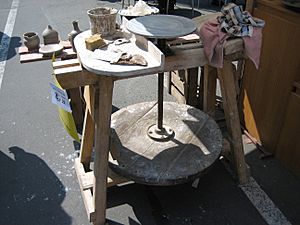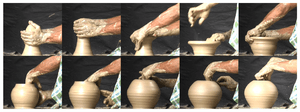Potter's wheel facts for kids
The potter's wheel is a special machine used to shape round objects made from ceramic clay. You might also hear it called a potter's lathe. It helps artists create bowls, plates, and vases.
This machine can also be used for other steps in making pottery. For example, potters use it to trim extra clay from dried pieces. They can also add cool designs or colorful rings while the clay spins.
Contents
History of the Potter's Wheel
Long ago, people made pottery by hand. They used a simple method called coiling. This meant rolling clay into long ropes and then pinching them together to form a pot. All the effort came directly from the potter's hands.
Things changed a lot with the invention of the "fast-wheel." Early versions of this wheel were heavy stone disks. They stored energy as they spun, making it much easier to shape clay quickly.
The Potter's Wheel in Ancient Stories
In ancient Egyptian mythology, there's a famous story about the god Khnum. People believed that Khnum used a potter's wheel to create the very first humans. It shows how important the wheel was, even in their myths!
How to Throw Clay on the Wheel
"Throwing" is the term for shaping clay on a potter's wheel. There are many ways to do it, but here's a common way for beginners:
- Getting Started: First, a lump of clay is prepared. It's often "wedged" to remove air bubbles and make it smooth. This clay is then placed firmly onto the center of the spinning wheel. Sometimes, a "bat" (a removable disk) is used on top of the wheel. This lets you take off your finished pot easily.
- Centering the Clay: The wheel spins fast, usually around 240-300 rotations per minute. The potter uses steady hands to push the clay into the exact center of the wheel. Water is used as a lubricant, but only a little. Too much water can make the clay weak. It's important to apply pressure smoothly all around the clay.
- Making the Clay Stronger: While the clay spins, the potter works it to make it stronger. This step is sometimes called "wheel wedging." It helps prepare the clay so it can be pulled up into thin walls later.
- Opening the Clay: Next, the potter gently pushes down into the center of the clay. This creates the "floor" of the pot and sets its thickness. Then, the clay is pulled outwards to make the floor wider.
- Pulling Up the Walls: The ring of clay around the floor is now ready to become the walls of the pot. The potter starts the first "pull" at high speed to thin the walls. For right-handed potters using a counter-clockwise wheel, the left hand is inside the pot, and the right hand is outside. The second and third pulls help create the final thickness and shape of the pot.
- The process of throwing a round pot

A skilled potter can quickly make a pot from a large amount of clay, sometimes up to 15 kilograms (about 33 pounds)! For very tall pots, potters might throw one section, let it firm up a bit, then add more clay and throw the next section. In China, two potters sometimes work together to make huge pots.
Other Pages to Explore
Images for kids
-
An electric potter's wheel, with a bat (green disk) and throwing bucket. A foot pedal controls the speed, like on a sewing machine.
-
Potter in Guatil, Costa Rica, using a hand-powered wheel in 2003.
See also
 In Spanish: Torno de alfarero para niños
In Spanish: Torno de alfarero para niños






